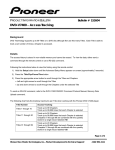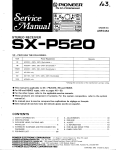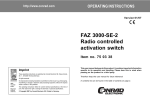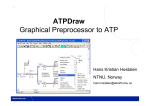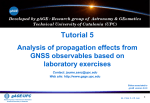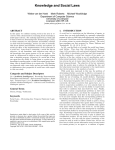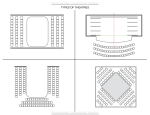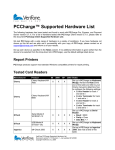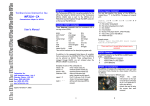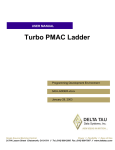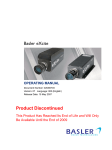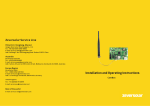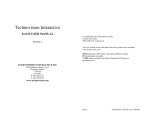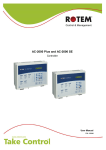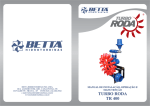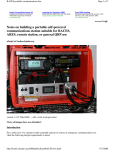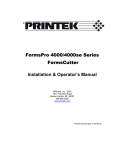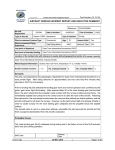Download RSSEND Ver 1.8 User manual
Transcript
RSSEND Version 1.8 User’s Guide Software card for Technovision PC-2 Controller Last Manual Update: September 2008 sd Technovision Interactive Inc. 1845 Sandstone Manor, Unit #2 Pickering, ONT, L1W 3X9 phone: (905) 420-5153 fax: (905) 420-0753 www.technovision.com Technovision Interactive Inc. RSSEND User’s Guide Getting Started Hardware requirements: Technovision PC-2 Controller with RSSEND program PC2-PRG Programming cable for downloading data file from a PC Optional RS232 cables Optional pushbuttons Program Description: RSSEND is a program for a Technovision PC-2 controller that can receive a text file downloaded from any computer, via the RS232 port, and store it away in battery backed up memory. The lines in the text file define what RS232 data is sent on the four RS232 ports on the PC-2. The text file also contains additional timing, button, and lighting commands. Transferring text file to PC2 When the PC2 is restarted with the PC2-PRG cable attached, the STATUS 2 light on the front of the PC2 is lit indicating the controller is waiting for a file to be downloaded. At this point the program can be transferred to the PC2 using a program such as HyperTerminal in Windows. The data format is to be set at 9600-baud, no parity, 8 data bits and 1 stop bit with handshaking set as NONE. Setting the transfer setting can be achieved through the File/Properties/Configure option in HyperTerminal. Transmitting (transferring) the text file can be achieved by using the Transfers/Send Text file function. While the text file is being transferred to the PC2, the STATUS 1 LED on the PC2is lit. Starting Program After the transfer of the text file to the PC-2, the PC2-PRG cable is replaced on the PC-2 with the RS232 cable(s). The PC-2 can then be restarted by pressing the RESET button on the back of the controller. Programming Specifications Text File format • The commands must be UPPERCASE with the spaces removed. • The first command in the file MUST be the RS232 initialize (INIT=) command • Initialize command digits MUST be 4 characters (i.e. 1111, 1249 etc.). • All lines must be terminated with a carriage return - standard for all text files. • Wait digits (minutes and seconds) MUST be 2 characters (i.e. 01, 09 etc.). RSSEND version 1.8 Page 1 / 7 Technovision Interactive Inc. RSSEND User’s Guide Command Syntax Command ; Description of Command Designates a comment line. The “;” must be the first character on the line. BLOCK=# This is the BUTTON LOCK command. If # is 1, then all buttons are to be lockout out and if # is 0, buttons are enabled. Buttons F and G are always available regardless of the BLOCK setting. Example: BLOCK=1 turns on the button lock. GOTO L L is the label that the program will branch (GO) to. Example: GOTO m will have the program branch to the line following the :m label :L[_##] L is the line label. BUTTON INPUTS use labels 1..9 and A..K, but any ASCII characters can be used when using the GOTO command (see above). The [ _##] is the optional button count used for SEQUENTIAL MODE. For example, if you would like the same button to perform different scripts each every time it is pressed, you can include the optional button count. When in SEQUENTIAL MODE, the script will stop executing whenever it encounters another line label where it will then wait for any button press (no matter what the BLOCK setting is). Button counts must occur in sequential order in the script, and when the program encounter the label with the button count of 99, it will reset the button count, and perform the command following the “99” line label. Example: REGULAR MODE: :2 is the line label for button 2. Whenever button 2 is pressed, the program will branch to this point in the program. SEQUENTIAL MODE: :2_01 is the line label for button 2 (first press). :2_02 is the line label for button 2 (second press). :2_99 is the line label for button 2 (end of processing). RELEASE Waits for the button to be released before continuing to the next line. INIT=#### RS232 Initialization command #### defines the baud speed for the 4 serial ports 1=1200 baud, 2=2400 baud, 4=4800 baud, and 9=9600. Data format is 8 bits, no parity and 1 stop Example: INIT=1299 sets the baud speed for serial port 1 at 1200 baud, serial port 2 at 2400 baud and serial ports 3 and 4 at 9600 baud. RSIN#[=I,L] # is the serial port you will receive from (1..4). I in the first character you are waiting for and L is the label the program will branch to if I was not received. Example: RSIN1=R,A will wait for any character to be received on serial port #1. If the character “R” was not received then the program branches to label “:A”, if not, it continues to the next line. RSWAIT# # is the serial port (1..4) that you will wait for a RS232 character. This command will wait up to 10 seconds for a character on that serial port before continuing to the next line in the script. Example: RSWAIT4 will wait up to 10 seconds for a character to be received on serial port 4. RSSEND version 1.8 Page 2 / 7 Technovision Interactive Inc. SERIAL#=data RSSEND User’s Guide # is the MUX value of the ports you will be transmitting to (HEX 1..F). data is the RS232 data to be sent. To set what RS232 serial ports you will be transmitting to, you must add the port values together. Port 1 has the value of 1, port 2 has the value of 2, port 3 has the value of 4 and port 4 has the value of 8. For example, if you wish to transmit to ports 1 and 3 the command would be SERIAL5=data. If non-ASCII characters are to be sent (i.e. carriage return) then they can be sent by including their hex value between square brackets. For example, to transmit a carriage return (hex value 0D) you would use the data string [0D]. Note: the hex value must be UPPERCASE. Example: SERIAL1=TEST1[0D] will transmit “TEST1” plus carriage return on serial port 1. SERIAL2=TEST2[0D] will transmit “TEST2” plus carriage return on serial port 2. SERIAL4=12345[0D] will transmit “12345” plus carriage return on serial port 3. SERIAL7=abcde[0D] will transmit “abcde” plus carriage return on serial port 1, 2 and 3. SERIALF=[0D][0D] will transmit two carriage returns on serial port 1, 2, 3 and 4. WAIT=mm:ss[.t] mm:ss is wait time in minutes and seconds. [.t] is the optional tenth of a second. Example WAIT=04:11 will wait 4 minutes and 11 seconds. WAIT=03:12.6 will wait 3 minutes and 12.6 seconds. LOOP=L,## L is the label to loop back to and ## is the number of times to perform the loop. Example: LOOP=X,12 will loop back to label X twelve times. LAMP=data data is the LD48 (or LAMP48) lamp settings (see examples on page 5) and uses the same format as the OUTPUT command (see below). Only applicable if a Technovision LD48 is attached to the PC2 (wiring instructions in LD48 manual). OUTPUT=data data is Parallel port setting (see examples on page 5). Parallel Port pin configuration can be found on page 6. Example: OUTPUT=01-03O,07O,09O,15F sets outputs 1 to 3, 7 and 9 ON and 15 OFF TMP=data data is the RS232 data to be sent to a Toshiba TMP-100U video wall (9600 baud, 8 bits, odd parity, 1 stop). This data is transmitted from the PC2 using Port A, bit 7 (Parallel Port pin 15). By using a Technovision LD1, attached to the Parallel port of the PC2, the signal is converted to RS232 data. If non-ASCII characters are to be sent (i.e. carriage return) then they can be sent by including the hex value between square brackets. For example, the hex value 0D is included in the data string as [0D]. Note: the hex value must be UPPERCASE. Example: TMP=[02][81][00][00][03] will transmit hex 02,81..etc to the Toshiba TMP wall processor. RSSEND version 1.8 Page 3 / 7 Technovision Interactive Inc. RSSEND User’s Guide WAITP#=frame # is the serial port of the Pioneer laserdisc/DVD player (1..4). frame is the frame number that the system will wait for. The WAITP command is also terminated if the player goes into STILL or PAUSE mode. If you are using a CAV laserdisc, then frame is entered as 5 digits (leading 0s included). If you are using a DVD-V7400 then frame is entered as 7 digits. On a DVD player, the 7 digits are the exact frame number and not the “time code” as on the LD-V4400 or LD-V8000 - those seven digits on a laserdisc represent the hour, minutes, seconds and frame number on the disc.(HMMSSFF). The WAITP command is available for CLV laserdiscs on only the LD-V4400 or LD-V8000. Example: WAITP1=01000 will wait until laserdisc player 1 reaches frame 1000 on a CAV laserdisc. WAITP1=0001000 will wait until DVD player 1 reaches frame 1000. WAITP1=0002200 will wait until DVD player 1 reaches frame 2200. WAITP1=9999999 will wait until DVD player goes into STILL/PAUSE mode. WAITT#=frame # is the serial port of the Toshiba SD-B100 DVD player that you will receive from (1..4). frame is the 7-digit frame number that the system will wait for. Those seven digits represent the hour, minutes, seconds and frame number on the disc.(HMMSSFF). Example: WAITT1=0124502 will wait until player 1 reaches minute 12, second 45 and frame 2. RSSEND version 1.8 Page 4 / 7 Technovision Interactive Inc. Sample text file Description INIT=1499 LAMP=01-08F,12O,14O BLOCK=1 ;DVD-V7400 STARTUP :S WAIT=00:05 SERIAL1=[0D] WAIT=00:02.5 SERIAL1=CLSA[0D] RSIN1=R,S :W BLOCK=0 WAIT=99:99 :1 RELEASE BLOCK=1 SERIAL1=FR1SE[0D] RSIN1 OUTPUT=01-03O WAIT=00:01 OUTPUT=01F,03F SERIAL1=2000SMPL[0D] RSWAIT1 WAITP1=0001500 OUTPUT=04O WAIT=00:01.5 OUTPUT=02F,04F WAITP1=9999999 GOTO W ;PLAY IN SYNCH :2 SERIAL1=1000SE[0D] SERIAL2=2000SE[0D] SERIAL4=3000SE[0D] SERIAL8=4000SE[0D] RSIN4 SERIALF=PL[0D] SERIAL1=2000PL[0D] SERIAL2=3000PL[0D] SERIAL4=4000PL[0D] SERIAL8=5000PL[0D] RSIN4 GOTO 2 ;BUTTON F :F BLOCK=1 RELEASE GOTO S RSSEND version 1.8 RSSEND User’s Guide SET PORT 1 TO 1200, PORT 2 TO 4800, REST TO 9600 BAUD LAMP OUTPUT 1 TO 8 OFF, 12 AND 14 ARE SET ON LOCK OUT ALL BUTTONS (EXCEPT “F” ANG “G”) COMMENT LABEL S WAIT 5 SECONDS SEND CARRIAGE RETURN TO DVD PLAYER 1 (TO CLEAR THE PLAYER’S BUFFER) WAIT 2.5 SECONDS TRANSMIT “CLSA” ON SERIAL PORT 1 WAIT FOR SINGLE CHARACTER “R” ON PORT 1. IF NOT “R”, GO TO LABEL “:S” LABEL W DISABLE BUTTON LOCKOUT WAIT FOREVER BUTTON 1 IS AN EXAMPLE OF A SEARCH AND WAITP COMMAND WAIT FOR BUTTON RELEASE ENABLE BUTTON LOCKOUT (NO BUTTON INTERRUPT) TRANSMIT TO SERIAL PORT 1 – SEARCH TO FRAME 1 (FRAME MODE SET BY FR) WAIT FOR ANY SEARCH COMPLETION CHARACTER ON PORT 1 TURN ON OUTPUT 1 TO 3 WAIT ONE SECOND TURN OFF OUTPUT 1 AND 3 SEND STOP MARKER FOR END OF SHOW (FRAME 2000) AND PLAY COMMAND WAIT UP TO 10 SECONDS FOR CHARACTER ON SERIAL PORT 1 WAIT FOR THE DVD-V7400 TO REACH FRAME 1500 (7 DIGITS) TURN ON OUTPUT 4 WAIT 1.5 SECONDS TURN OFF OUTPUT 2 AND 4 WAIT FOR PLAYER TO GO INTO STILL/PAUSE MODE GOTO LABEL W BUTTON 2 PLAYS FOUR PIONEER PLAYERS IN SYNC TRANSMIT TO SERIAL 1 – SEARCH TO FRAME 1000 TRANSMIT TO SERIAL 2 – SEARCH TO FRAME 2000 TRANSMIT TO SERIAL 3 – SEARCH TO FRAME 3000 TRANSMIT TO SERIAL 4 – SEARCH TO FRAME 4000 WAIT FOR ANY CHARACTER FROM SERIAL PORT 4 (SEARCH COMPLETION) TRANSMIT “PL” TO ALL PORTS TRANSMIT END FRAME TO SERIAL 1 TRANSMIT END FRAME TO SERIAL 2 TRANSMIT END FRAME TO SERIAL 3 TRANSMIT END FRAME TO SERIAL 4 WAIT FOR ANY CHARACTER ON PORT 4 (COMPLETION CODE) BACK TO LABEL 2 (REPEAT) BUTTON F CAN BE USED AS A RESTART – NOT AFFECTED BY BLOCK=1 BUTTON LABEL LOCKOUT ALL BUTTONS WAIT FOR BUTTON RELEASE GO to LABEL :S (STARTUP) Page 5 / 7 Technovision Interactive Inc. RSSEND User’s Guide Parallel Port Outputs (DB25M connector) Outputs on the Parallel Port are 5 volts DC rated at 35 ma each with the total output for the port not to exceed 200ma. Output 1 2 3 4 5 6 7 8 9 10 11 12 13 14 15 16 GROUND Pin on Parallel Port 6 18 5 17 4 16 3 15 – Do not use if using LD-1 with TMP command 10 – Do not use if using LD48 22 – Do not use if using LD48 9 – Do not use if using LD48 21 8 20 7 19 1 or 13 Button Configuration (pins on keypad port) PC2 keypad port RETURN 0 (2) GREEN RETURN 1 (3) BLUE RETURN 2 (4) WHITE RETURN 3 (5) BLACK SCAN 0 (6) BROWN 1 SCAN 1 (7) RED 2 SCAN 2 (8) ORANGE 3 SCAN 3 (9) YELLOW 4 GROUND (1) 5 ! 7 8 I 9 A B C J D E **F **G K H Contact requirements: The signals that are carried through the keypad port are TTL (low voltage signals) level – it is recommended that the momentary contact closure be within forty (40) feet of the controller. Button Example: The “6” button is wired to SCAN 1 (pin 7 on keypad assembly) and RETURN 1 (pin 3) which are usually the RED and BLUE wires on a button assembly. When this button is pressed, the program will start running at label “:6” ** Note: the BLOCK=1 (button lockout command) does not affect Buttons “F” and “G”. RSSEND version 1.8 Page 6 / 7 Technovision Interactive Inc. RSSEND User’s Guide Serial Port pin configuration on the COMMUNICATIONS PORT of the PC2 SERIAL # 1 2 3 4 Tx PIN (OUTPUT) 2 14 4 16 Rx PIN (INPUT) 3 15 5 17 DATA GROUND 6 18 7 19 For example: SERIAL1=CLSA[0D] will transmit “CLSA”+ <carriage return> on pin 2 of the communications port. Version Changes Version # 1.4 Changes TMP command added WAITP (5 digit) command added 1.5 WAITT command added WAITP (7 digit ) command added 1.6 RSWAIT command added FEB 2001 1.7 Additional Buttons H..K added to keypad port FEB 2003 1.8 Added sequential play 1/10-second timer added to WAIT SEPT 2004 RSSEND version 1.8 Date Page 7 / 7








